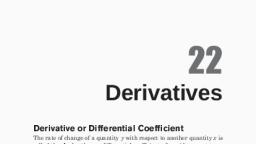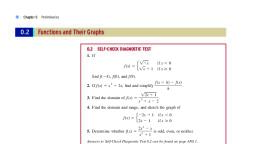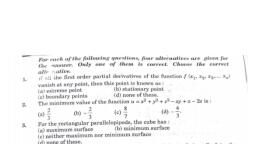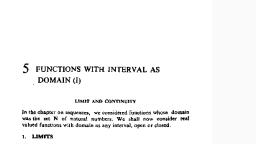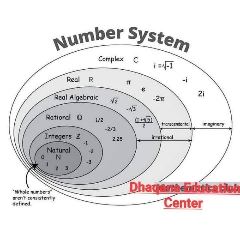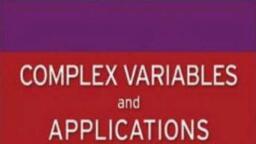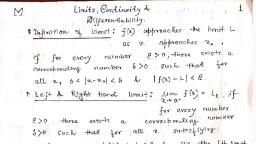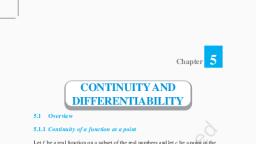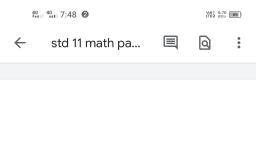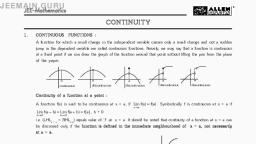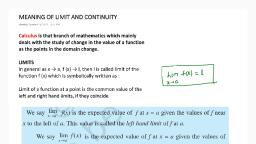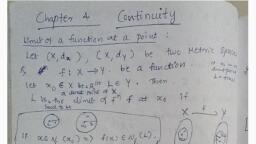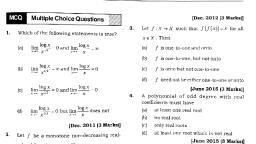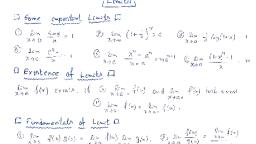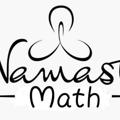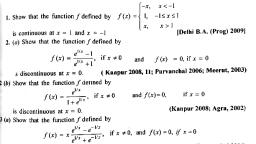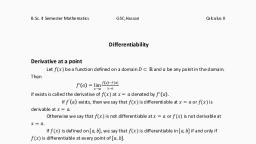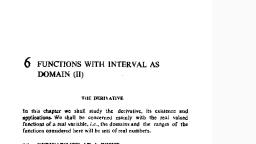Page 1 :
21, , Limits, Continuity, & Differentiability, Limit, Let y = f ( x ) be a function of x. If at x = a,f ( x ) takes indeterminate form, 0 ∞, ∞, 0, 0, , , ∞ − ∞ , 0 × ∞ , 1 , 0 and ∞ , then we consider the values of the, 0 ∞, , function at the points which are very near to a. If these values tend to, a definite unique number as x tends to a, then the unique number, so, obtained is called the limit of f ( x ) at x = a and we write it as lim f ( x )., x→a, , Left Hand and Right Hand Limits, If values of the function, at the points which are very near to the left of, a, tends to a definite unique number, then the unique number so, obtained is called the left hand limit of f ( x ) at x = a. We write it as, f ( a − 0) = lim f ( x ) = lim f ( a − h ), x → a−, , h → 0+, , Similarly, right hand limit is written as, f ( a + 0) = lim f ( x ) = lim f ( a + h ), x → a+, , h → 0+, , Existence of Limit, lim f ( x ) exists, if, , x→a, , (i) lim f ( x ) and lim f ( x ) both exist, x → a−, , x → a+, , (ii) lim f ( x ) = lim f ( x ), x → a−, , x → a+, , Uniqueness of Limit, If lim f ( x ) exists, then it is unique, i.e. there cannot be two distinct, x→a, , numbers l1 and l2 such that when x tends to a, the function f ( x ) tends, to both l1 and l2.
Page 2 :
Limits, Continuity & Differentiability, , 221, , Fundamental Theorems on Limits, If f ( x ) and g( x ) are two functions of x such that lim f ( x ) and lim g( x ), x→a, , x→a, , both exist, then, (i) lim [ f ( x ) ± g( x )] = lim f ( x ) ± lim g( x ), x→a, , x→a, , x→a, , (ii) lim [kf ( x )] = k lim f ( x ), where k is a fixed real number., x→a, , x→a, , (iii) lim [ f ( x ) g( x )] = lim f ( x ) lim g( x ), x→a, , x→a, , x→a, , lim f ( x ), , (iv) lim, , x→a, , f(x) x → a, =, , provided lim g( x ) ≠ 0, x→a, g( x ) lim g( x ), x→a, , lim g ( x ), , x→ a, (v) lim [ f ( x )] g ( x ) = lim f ( x ), x → a, , x→a, , (vi) lim ( gof ) ( x ) = lim g[ f ( x )] = g lim f ( x ), x → a, , x→a, x→a, (vii) lim log f ( x ) = log lim f ( x ) , provided lim f ( x ) > 0., x → a, x→a, x→a, , lim f ( x ), , (viii) lim e f ( x ) = ex → a, x→a, , (ix) If f ( x ) ≤ g( x ) for every x excluding a, then lim f ( x ) ≤ lim g( x )., x→a, , (x) lim f ( x ) = lim f ( x ), x→a, , x→a, , (xi) If lim f ( x ) = + ∞ or − ∞ , then lim, x→a, , x→a, , Important Results on Limits, 1. Algebraic Limits, (i) lim, , x→ a, , xn − an, = na n −1, n ∈ Q, x−a, , (1 + x )n − 1, = n , n ∈Q, x→ 0, x, , (ii) lim, , 1, =0, f(x), , x→a
Page 3 :
222, , Handbook of Mathematics, , 2. Trigonometric Limits, sin x, x, = 1 = lim, →, 0, x, x, sin x, tan x, x, (ii) lim, = 1 = lim, x→ 0, x → 0 tan x, x, (i) lim, , x→ 0, , (iii) lim, , x→ 0, , sin−1 x, x, = 1 = lim, x → 0 sin−1 x, x, , x, tan−1 x, = 1 = lim, x→ 0, x → 0 tan−1 x, x, sin x °, π, (v) lim, =, x→ 0, x, 180, , (iv) lim, , (vi) lim cos x = 1, x→ 0, , (vii) lim, , sin( x − a ), =1, x−a, , (viii) lim, , tan( x − a ), =1, x−a, , x→ a, , x→ a, , (ix) lim sin−1 x = sin−1 a ,|a|≤ 1, x→ a, , (x) lim cos−1 x = cos−1 a ,|a|≤ 1, x→ a, , (xi) lim tan−1 x = tan−1 a , − ∞ < a < ∞, x→ a, , sin x, cos x, = lim, =0, x→ ∞, x, x, 1, sin, x, (xiii) lim, =1, 1, x→ ∞, x, 1 − cos x, (xiv) lim, =0, x→0, x, (xii) lim, , x→ ∞, , (where, x is measured in radian), , 3. Exponential Limits, (i) lim, , x→ 0, , (ii) lim, , x→ 0, , ex − 1, =1, x, ax − 1, = loge a, a > 0, x
Page 4 :
Limits, Continuity & Differentiability, (iii) lim, , x→ 0, , 223, , e λx − 1, = λ, where ( λ ≠ 0)., x, , 0,, , 1,, , (iv) lim a x = , x→ ∞, ∞ ,, , does not exist,, , 0≤ a < 1, a=1, a>1, a< 0, , 4. Logarithmic Limits, (i) lim, , x→ 0, , loge (1 + x ), =1, x, , (ii) lim loge x = 1, x→ e, , loge (1 − x ), = −1, x, loga (1 + x ), (iv) lim, = loga e, a > 0, ≠ 1, x→ 0, x, , (iii) lim, , x→ 0, , 5. Limits of the Form lim ( f ( x )) g ( x ), x →a, , lim φ ( x ) log f ( x ), , If lim f(x) exists and positive, then lim [ f ( x )]φ ( x ) = ex → a, x→a, , x→a, , 6. Limits of the Form 1∞, To evaluate the exponential form 1∞ , we use following results., lim, , f (x ), , If lim f ( x ) = lim g( x ) = 0, then, lim { 1 + f ( x )}1/ g ( x ) = ex → a g ( x ), x→ a, , x→ a, , x→ a, , Or If lim f ( x ) = 1 and, x→ a, , Then, lim { f ( x )}, , g(x ), , x→ a, , lim g ( x ) = ∞ ,, , x→ a, , lim { f ( x ) − 1} g ( x ), , = lim { 1 + f ( x ) − 1} g ( x ) = ex→ a, x→a, , Particular Cases, 1, , x, , (i) lim (1 + x ) x = e, x→ 0, , (iii) lim (1 +, x→ 0, , 1, λx ) x, , = eλ, , 1, , (ii) lim 1 + = e, x→ ∞ , x, x, , λ, , (iv) lim 1 + = eλ, x→ ∞ , x
Page 5 :
224, , Handbook of Mathematics, , Methods of Evaluating Limits, 1. Determinate Forms (Limits by Direct Substitution), To find lim f ( x ), we substitute x = a in the function. If the value comes, x→a, , out to be a definite value, then it is the limit., Thus, lim f ( x ) = f ( a ) provided it exists., x→a, , 2. Indeterminate Forms, While evaluating lim f ( x ), if direct substitution of x = a leads to one of, x→a, , 0 ∞, ; ; ∞ − ∞ ; 0 × ∞ ; 1∞ , 00 and ∞ 0, then these limits, 0 ∞, can be determined by using L’ Hospital’s rule or by some other method, given below., , the following form, , (i) Limits by Factorisation, , 0, f(x), attains form, then x − a must be a factor of numerator, 0, g( x ), and denominator which can be cancelled out., If lim, , x→a, , (ii) Limits by Rationalisation, , f(x), 0, ∞, form and either f ( x ) or g( x ) or both, attains form or, g( x ), 0, ∞, involve expression consisting of square root, then this can be evaluated, by rationalising., If lim, , x→a, , (iii) Limits by Substitution, , In order to evaluate lim f ( x ), we may substitute x = a + h, x→a, , (or x = a − h), so that x → a changes to h → 0., Thus, lim f ( x ) = lim f ( a ± h ), x→a, , h→0, , (iv) Limits when x → ∞, , ∞, f(x), is of the form and both f ( x ) and g( x ) are polynomial of x., ∞, g( x ), Then, we divide numerator and denominator by the highest power of x, 1 1 1, and put 0 for , 2 , 3 , etc., x x x, , If lim, , x→∞
Page 6 :
Limits, Continuity & Differentiability, Note If m and n are positive integers and a0 , b0 ≠ 0 are, a0, b ,, 0, a0 x m + a1 x m−1 + K + am − 1 x + am 0,, =, lim, x → ∞ b x n + b x n − 1 + ... + b, 0, 1, n − 1 x + bn, , ∞,, , − ∞,, , 225, , real numbers, then, if m = n, if m < n, if m > n, a0 b0 > 0, if m > n, a0 b0 < 0., , (v) L’Hospital’s Rule, , If f ( x ) and g( x ) be two functions of x such that, (i) lim f ( x ) = lim g( x ) = 0, x→ a, , x→ a, , (ii) both are continuous at x = a., (iii) both are differentiable at x = a., (iv) f ′ ( x ) and g′ ( x ) are continuous at the point x = a , then, f(x), f ′ (x), ., = lim, lim, x → a g( x ), x → a g′ ( x ), Above rule is also applicable, if lim f ( x ) = ∞ and lim g( x ) = ∞., x→ a, , Note, , x→ a, , f′ ( x), 0, ∞, If lim, assumes the indeterminate form, or, and f ′ ( x ), g′ ( x ), x→ a g′ ( x ), 0, ∞, satisfy all the condition embeded in L’Hospital’s rule, then we can repeat, f′ ( x), f′ ′ ( x), f′ ( x), i.e. lim, ., the application of this rule on, to get lim, x→ a g′ ( x ), x→ a g′ ′ ( x ), g′ ( x ), , Limit Using Expansions, Many limits can be evaluated very easily by applying expansion of, expressions involving in it. Some of the standard expansions are, (i) (1 + x )n = 1 + n C1x + n C2x 2 + ... + n Cn x n , n ∈ N , x ∈ R, n( n − 1) 2, x + ... ∞ , − 1 < x < 1, n ∈ Q, 2!, x x 2 x3, (iii) ex = 1 +, +, +, + ... ∞ , x ∈ R, 1! 2! 3!, ( x loge a )2, (iv) a x = ex log a = 1 + x loge a +, + ... ∞ , x ∈ R, a > 0, a ≠ 1, 2!, x 2 x3 x 4, (v) loge (1 + x ) = x −, +, −, + ... ∞ , − 1 < x ≤ 1, 2, 3, 4, (ii) (1 + x )n = 1 + nx +, , (vi) loge (1 − x ) = − x −, , x 2 x3, −, − ... ∞ , − 1 ≤ x < 1, 2, 3
Page 7 :
226, , Handbook of Mathematics, x3 x5, +, − ... ∞ , x ∈ R, 3! 5!, x2 x4, cos x = 1 −, +, − ... ∞ , x ∈ R, 2! 4!, x3, 2 5, tan x = x +, +, x +..., 3 15, x3 9x5, sin−1 x = x +, +, +..., 3!, 5!, x3 x5 x7, tan−1 x = x −, +, −, +..., 3, 5, 7, , (vii) sin x = x −, (viii), (ix), (x), (xi), , Some Important Results, 1 − cos m x m 2, = 2, x → 0 1 − cos n x, n, , (i) lim, (ii) lim, , x→ 0, , (iii) lim, , cos ax − cos bx a 2 – b2, =, cos cx − cos dx c2 – d 2, cos mx − cos nx, x2, , x→ 0, , m, = , n, , p, , m, = , p, tan nx n , , p, , p, , (iv) lim, , x→ 0, , (v) lim, , x→ 0, , (vi) lim, , x→ a, , (vii) lim, , x→ 0, , (viii) lim, , x→ 0, , =, , sin mx, ( nx ) p, tan p mx, xa − ax, x −a, x, , a, , =, , n 2 − m2, 2, , 1 − log a, 1 + log a, , (1 + x )m − 1, (1 + x )n − 1, , =, , (1 + bx )m − 1, (1 + ax ) − 1, n, , m, n, =, , mb, na, , a, , (ix) lim (1 + ax ) b / x = lim 1 + , x→ ∞ , x→ 0, x, , bx, , (x) lim ( x n + y n )1/ n = y, ( 0 < x < y ), n→ ∞, , (xi) lim (cos x + a sin bx )1/ x = eab, x→ 0, , (xii) lim, , x→ ∞, , xn, ex, , = 0, ∀ n, , = eab
Page 8 :
Limits, Continuity & Differentiability, , 227, , m, , x, , (xiii) lim cos = 1, m→ ∞ , m, x, x, x, x, sin x, (xiv) lim cos cos cos … cos n =, n→ ∞, 2, 4, 8, x, 2, , Sandwich Theorem, Let f ( x ), g ( x ) and h ( x ) be real functions such that, f ( x ) ≤ g ( x ) ≤ h( x ) , ∀ x ∈ (α , β ) − { a }, If, lim f ( x ) = l = lim h( x ),, x→a, , x→a, , lim g ( x ) = l, , then, , x→a, , y = h (x), y = g (x), y = f(x), , x=α, , x=a, , x=β, , Y, , y = h (x), y = g (x), y = f (x), , O, , X, , a, , Continuity, If the graph of a function has no break or gap, then it is continuous. A, function which is not continuous is called a discontinuous function., e.g. f ( x ) = sin x is continuous, as its graph has no break or gap., Y, , X', , –π, –2π –3π, 2, , –π/2, , Y', , O π/2, , 1, While f ( x ) = is discontinuous at x = 0., x, , 3π, π2, , 2π, X
Page 9 :
228, , Handbook of Mathematics, Y, , X', , X, , O, 1, f (x ) = x, Y', , Continuity of a Function at a Point, Let f be a real function and a be a point in the domain of f. We say f is, continuous at a, if lim f ( x ) = f ( a )., x→a, , lim f ( x ) = lim f ( x ) = f ( a ), , i.e., , x → a−, , x → a+, , Thus, f ( x ) is continuous at x = a, if lim f ( x ) exists and equals to f ( a )., x→a, , Note, , If a function is not continuous at x = a, then it is said to be discontinuous, at x = a., , Continuity of a Function in an Interval, (i) A function f ( x ) is said to be continuous in an open interval ( a , b),, if f ( x ) is continuous at every point of the interval., (ii) A function f ( x ) is said to be continuous in a closed interval [a , b],, if f ( x ) is continuous in ( a , b). In addition, f ( x ) is continuous at, x = a from right and f ( x ) is continuous at x = b from left., Note A real function f is said to be continuous in its domain, if it is continuous, at every point of its domain., , Discontinuity of a Function, A function f ( x ) can be discontinuous at a point x = a in any one of the, following ways., (i) f ( a ) is not defined., (ii) LHL and RHL both exist but unequal i.e., lim f ( x ) ≠ lim f ( x ), , x → a−, , x → a+, , (iii) Either lim f ( x ) or lim f ( x ) or both non-existing or infinite., x → a−, , x → a+, , (iv) LHL and RHL both exist and equal but not equal to f ( a ),, i.e. lim f ( x ) = lim f ( x ) ≠ f ( a ), x → a−, , x → a+
Page 10 :
Limits, Continuity & Differentiability, , 229, , Types of Discontinuity, 1. Removable Discontinuity, , If lim f ( x ) exists and either it is not equal to f ( a ) or f ( a ) is not, x→a, , defined, then the function f ( x ) is said to have a removable, discontinuity (missing point discontinuity) of x = a., This discontinuity can be removed by suitably defining the function at, x = a., 2. Non-removable discontinuity, , Non-removable discontinuity is of following two types, (i) Discontinuity of first kind, , If, , lim f ( x ) and, , x → a−, , lim f ( x ) both exist but are not equal, then the, , x → a+, , function f ( x ) is said to have a non-removable discontinuity of first kind, at x = a., Note In this case, we also say that f ( x ) has jump discontinuity at x = a and, we defind lim f ( x ) − lim f ( x ) = jump of the function at x = a., x → a−, , x→ a+, , (ii) Discontinuity of second kind, , If at least one of the limits lim f ( x ) or lim f ( x ) does not exist or at, x → a−, , x → a+, , least one of these is ∞ or − ∞, then the function f ( x ) is said to have a, non-removable discontinuity of second kind at x = a., , Important Points to be Remembered, (i) If f ( x ) is continuous and g ( x ) is discontinuous at x = a, then the product, function φ ( x ) = f ( x ) ⋅ g( x ) is not necessarily be discontinuous at x = a., (ii) If f ( x ) and g ( x ) both are discontinuous at x = a, then the product function, φ ( x ) = f ( x ) ⋅ g ( x ) is not necessarily be discontinuous at x = a., (iii) There are some functions which are continuous only at one point., x , if x ∈Q, + x , if x ∈Q, are both continuous only at, and g ( x ) = , e.g. f ( x ) = , 0 , if x ∉Q, − x , if x ∉Q, x = 0., , Fundamental Theorems of Continuity, (i) If f and g are continuous functions, then, (a) f ± g and fg are continuous., (b) cf is continuous, where c is a constant.
Page 11 :
230, , Handbook of Mathematics, (c), , f, is continuous at those points, where g( x ) ≠ 0., g, , (ii) If g is continuous at a point a and f is continuous at g( a ), then fog, is continuous at a., (iii) If f is continuous in [a , b] , then it is bounded in [a , b] i.e. there, exist m and M such that, m ≤ f ( x ) ≤ M , ∀ x ∈ [a , b],, where m and M are called minimum and maximum values of, f ( x ) respectively in the interval [a , b]., (iv) If f is continuous in its domain, then| f| is also continuous in its, domain., (v) If f is continuous at a and f ( a ) ≠ 0, then there exists an open, interval ( a − δ , a + δ ) such that for all x ∈( a − δ , a + δ ), f ( x ) has the, same sign as f ( a )., (vi) If f is a continuous function defined on [a , b] such that f ( a ) and, f ( b) are of opposite sign, then there exists atleast one solution of, the equation f ( x ) = 0 in the open interval ( a , b)., (vii) If f is continuous on [a , b] and maps [a , b] into [a , b], then for, some x ∈[a , b], we have f ( x ) = x., 1, is also continuous in, (viii) If f is continuous in domain D, then, f, D − { x : f ( x ) = 0}., , Differentiability, If the curve has no break point and no sharp edge, then it is, differentiable., , Differentiability (or Derivability) of a Function at a Point, The function f ( x ) is differentiable at a point P iff there exists a unique, tangent at point P., In other words, f ( x ) is differentiable at a point P iff the curve does not, have P as a corner point i.e. the function is not differentiable at those, points on which function has holes or sharp edges., If the shape of curve is any of the following forms,, A, A, (i), , (ii), , then the function is not differentiable at point A., , A, (iii)
Page 12 :
Limits, Continuity & Differentiability, , 231, , Mathematically A function f ( x ) is said to be differentiable at a point, a in its domain, if lim, , x→a, , or if, , lim, , x → a−, , f(x) − f(a), exist finitely, x−a, , f(x) − f(a), f(x) − f(a), = lim, x−a, x−a, x → a+, , i.e. Left Hand Derivative (LHD) = Right Hand Derivative (RHD), or, , Lf ′ ( a ) = Rf ′ ( a ), , Differentiability of a Function in an Interval, (i) A function f ( x ) is said to be differentiable in an interval ( a , b), if, f ( x ) is differentiable at every point of this interval ( a , b)., (ii) A function f ( x ) is said to be differentiable in a closed interval, [a , b], if f ( x ) is differentiable in ( a , b), in addition f ( x ) is, differentiable at x = a from right and at x = b from left., Note A real function f is said to be differentiable if it is differentiable at, every point of its domain., , Fundamental Theorems of Differentiability, (i) The sum, difference, product and quotient of two differentiable, function, provided it is defined, is differential., (ii) The composition of differential function is a differential, function., (iii) If f ( x ) and g( x ) both are not differential function, then the sum, function f ( x ) + g( x ) and the product function f ( x ) ⋅ g( x ) can be, differential function., , Relation between Continuity and Differentiability, (i) If a function f ( x ) is differentiable at x = a, then f ( x ) is necessarily, continuous at x = a but the converse is not necessary true, i.e. if, a function is continuous at x = a, then it is not necessary that f is, differentiable at x = a, (ii) If f is not continuous at x = a, then f is not differential at x = a.
Page 13 :
232, , Handbook of Mathematics, , Continuity and Differentiability of Different Functions, Function, , Curve, , Identity, , f (x) = x, , Constant, , f (x) = c, , Domain and Range, , Continuity and, Differentiability, , Domain = R,, Range = ] − ∞ , ∞ [ = R, Domain = R,, Range = {c}, where, c → constant, , f (x) =, a0 + a1x + a2 x2, Polynomial, , + K + an x n , where, a0, a1, ..., an are, real numbers and, n ∈ N., , Square Root, , f (x) =, , Greatest integer, , f (x) = [x], , x, , Continuous and, Differentiable, everywhere, , Domain = R, , Domain = [0, ∞),, Range = [0, ∞), , Continuous and, differentiable in, (0, ∞), , Domain = R,, Range = I, Domain = R,, , Least integer, , f (x) = (x), , Fractional part, , f (x) = {x} = x − [x], , Signum, , | x|, f (x) =, x, −1, x < 0, = 0, x = 0, 1, x > 0, , , Exponential, , f (x) = ax , a > 0, a ≠ 1, , Logarithmic, , f (x) = log a x; x, a > 0 Domain = (0, ∞),, and a ≠ 1, Range = R, , Range = I, Domain = R,, , Other than, integral values it, is continuous, and differentiable, , Range = [0, 1), , Domain = R,, Range = {− 1, 0, 1}, , Continuous and, differentiable, everywhere, except at x = 0, , Domain = R,, Range = ] 0, ∞ [, , Continuous and, differentiable in, their domain
Page 14 :
Limits, Continuity & Differentiability, Functions, sine, cosine, , tangent, , Curve, y = sin x, y = cos x, , y = tan x, , Domain and Range, , secant, , y = cosec x, , y = sec x, , Continuity and, Differentiability, , Domain = R,, Range = [ − 1, 1], Domain = R,, Range = [ − 1, 1], Domain, π, = R − (2n + 1) | n ∈ Z ,, 2, , , Range = R, , cosecant, , 233, , Domain = R − {nπ | n ∈ Z}, Range = {− ∞, − 1] ∪ [1, ∞), , Continuous and, differentiable in, their domain, , Domain, π, = R − (2n + 1) | n ∈ Z ,, 2, , , Range = (− ∞, − 1] ∪ [1, ∞), , cotangent, , y = cot x, , Arc sine, , y = sin−1 x, , Arc cosine, , y = cos −1 x, , Arc tangent, , y = tan−1x, , Arc cosecant, , y = cosec −1x, , Arc secant, , y = sec −1 x, , Arc cotangent, , y = cot −1 x, , Domain = R − {nπ | n ∈ Z},, Range = R, Domain = [− 1, 1],, π π, Range = − , , 2 2 , Domain = [− 1, 1],, Range = [0, π], Domain = R,, π π, Range = − , , 2 2, Domain = (− ∞, 1] ∪ [1, ∞),, π π, Range = , − {0}, 2 2, Domain = (−∞, −1] ∪ [1, ∞),, π, Range = [0, π] − , 2 , Domain = R,, Range = (0, π), , Continuous and, differentiable in, their domain



